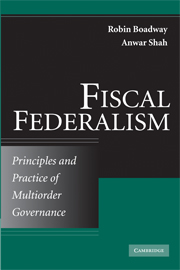Book contents
- Frontmatter
- Contents
- Preface
- PART ONE DESIGNING FISCAL CONSTITUTIONS
- 1 Introduction to Federalism and the Role of Governments in Federal Economies
- 2 The Decentralization of Government Authority
- 3 Expenditure Assignment
- 4 Revenue Assignment
- 5 Natural Resources Ownership and Management in a Federal System
- 6 Local Governance in Theory
- 7 Local Governance in Practice
- PART TWO REVENUE SHARING AND FISCAL TRANSFERS
- PART THREE FINANCE AND PROVISION OF PUBLIC SERVICES
- PART FOUR CHALLENGES AND RESPONSES
- References
- Index
1 - Introduction to Federalism and the Role of Governments in Federal Economies
Published online by Cambridge University Press: 05 June 2012
- Frontmatter
- Contents
- Preface
- PART ONE DESIGNING FISCAL CONSTITUTIONS
- 1 Introduction to Federalism and the Role of Governments in Federal Economies
- 2 The Decentralization of Government Authority
- 3 Expenditure Assignment
- 4 Revenue Assignment
- 5 Natural Resources Ownership and Management in a Federal System
- 6 Local Governance in Theory
- 7 Local Governance in Practice
- PART TWO REVENUE SHARING AND FISCAL TRANSFERS
- PART THREE FINANCE AND PROVISION OF PUBLIC SERVICES
- PART FOUR CHALLENGES AND RESPONSES
- References
- Index
Summary
This monograph is a study of economic decision making by governments in a federation. A federation is simply a multilevel system of government in which different levels of government exist, each of which has some independent authority to make economic decisions within its jurisdiction. By economic decisions, we include a variety of things. Governments can acquire resources to provide public goods and services. Expenditures for these purposes can be of a current nature (e.g., hiring employees, purchasing materials) and a capital nature (e.g., buildings, infrastructure). Governments can raise revenues in order to finance services provided by the private or nonprofit sectors, such as hospitals, universities, or insurance. They can arrange to have resources redistributed among households in the economy. They can introduce regulations in the markets of the private sector so as to influence resource allocation there; or they can interfere with the pricing mechanism as an alternative way of achieving resource allocation or redistributive effects, such as through subsidizing or taxing certain activities. They can also attempt to influence the aggregate amount of activity that occurs in the economy both through budgetary actions and through changes in the amount of money and credit circulating in the economy.
BASIC CONCEPTS OF FEDERALISM
Constitutional divisions of powers among various orders of government fall into three categories: unitary, federal, and confederal.
- Type
- Chapter
- Information
- Fiscal FederalismPrinciples and Practice of Multiorder Governance, pp. 4 - 60Publisher: Cambridge University PressPrint publication year: 2009
- 1
- Cited by



